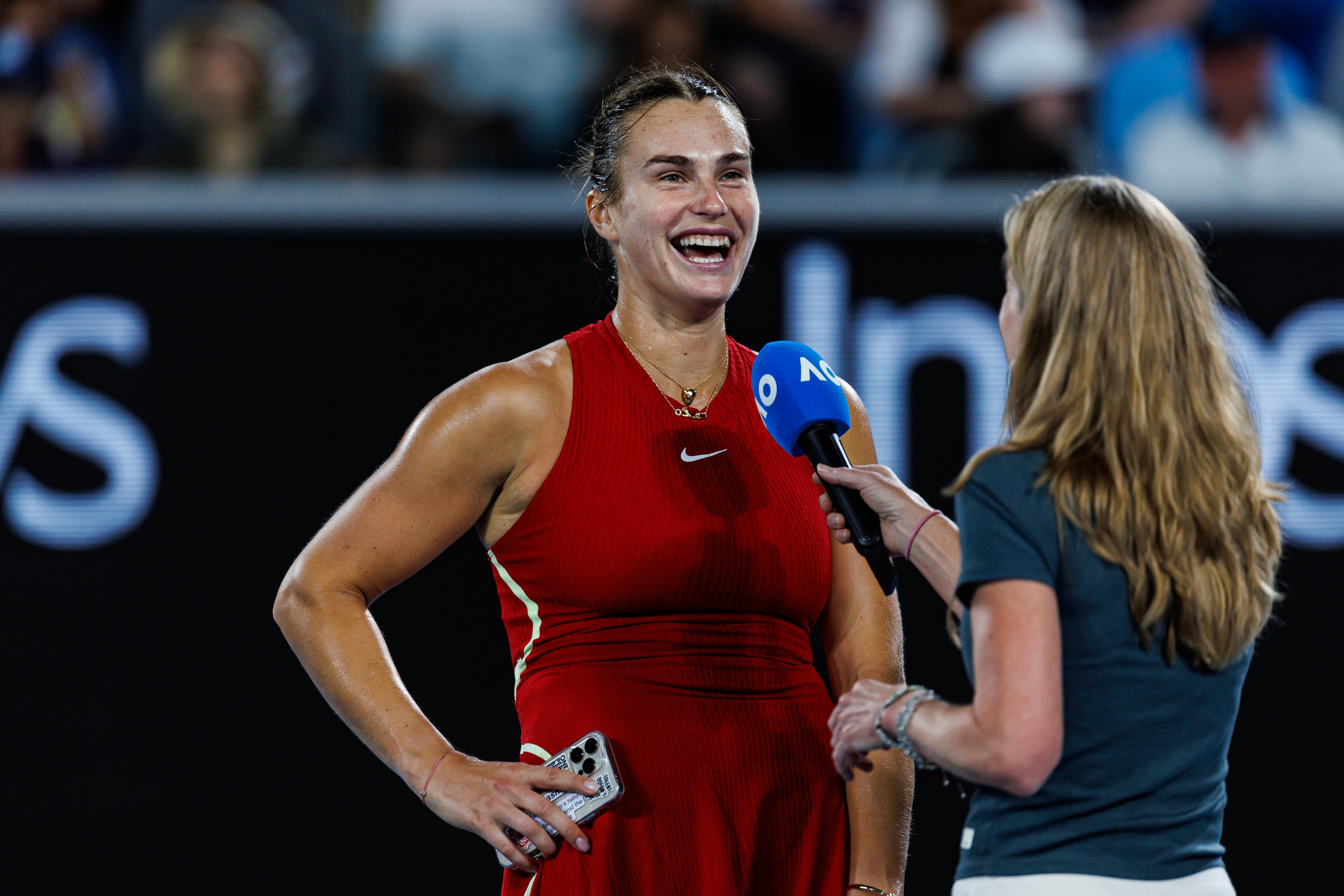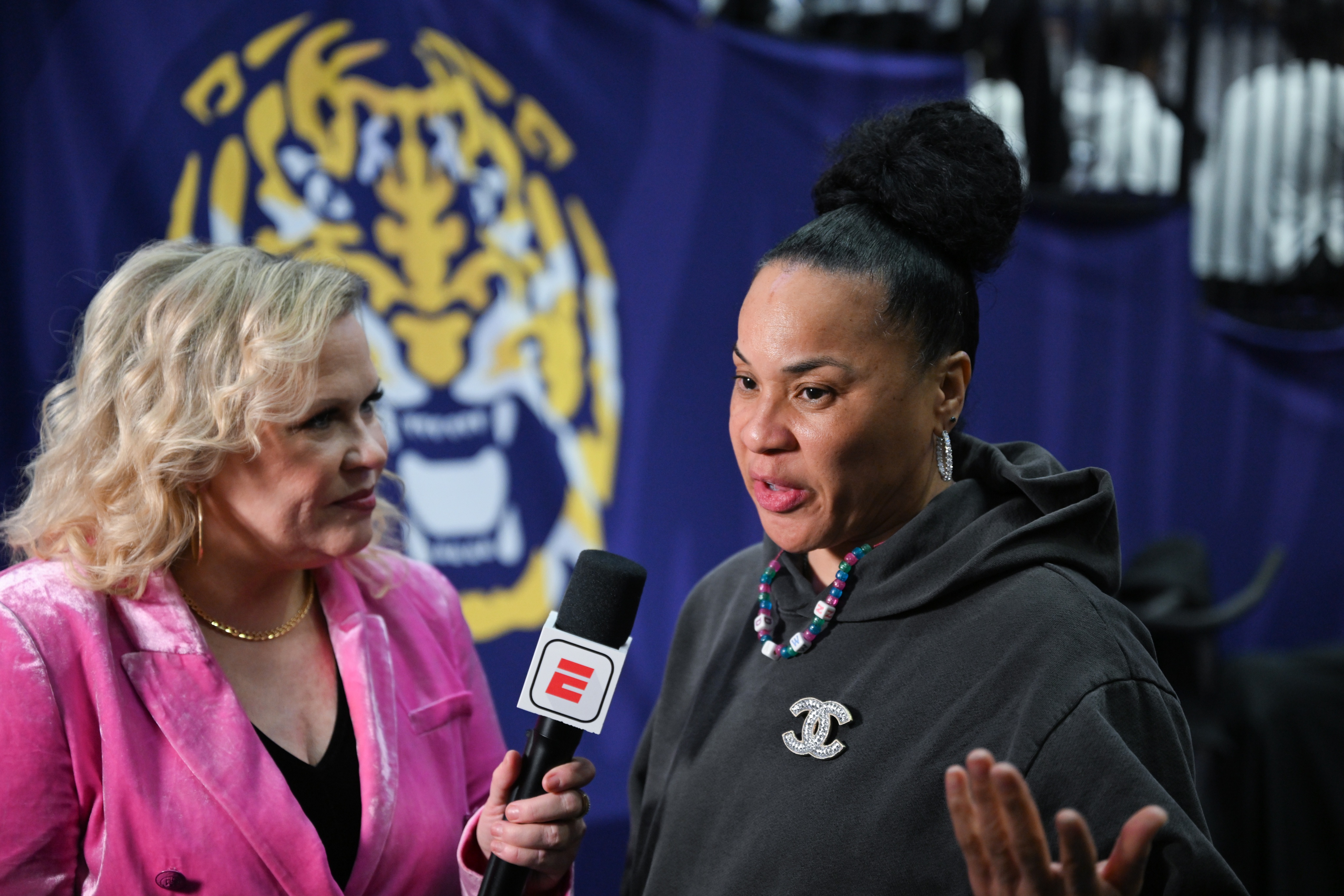ESPN reporter & play-by-play commentator Holly Rowe talks to South Carolina Gamecocks head coach Dawn Staley before a game against the LSU Lady Tigers at Pete Maravich Assembly Center. © Matthew Hinton-USA TODAY Sports
Anyone who’s been involved in women’s sports media knows the “4%” figure — the data point commonly used in recent years to highlight the share of women’s sports media coverage relative to the whole.
The 4% became a rallying cry for nascent media companies like The GIST, TOGETHXR and Just Women’s Sports, all launched since 2018 with the intention of upending the status quo by focusing on dedicated women’s sports coverage.
As it turns out, the 4% number was growing more steadily than many people realized.
An October 2023 study conducted by The Collective, Wasserman’s women-focused practice, found that women’s sports now comprise 15% of total sports media coverage, thanks in large part to the growth of streaming and social media. While 15% is by no means an endgame for women’s sports media advocates, the updated data point can go a long way toward a solution. As Wasserman Executive Vice President, Global Insights Shelley Pisarra said in the report, “Persistent, incorrect assumptions of lower media representation for women’s sports have created hesitancy around investment, whereas truth will spark opportunity.”
With the data supporting global momentum, in 2024 women’s sports media coverage is primed for a breakthrough. Here’s what I’d like to see to make sure the women’s sport’s moment turns into an institution.
1. Legacy media, stand up
Women’s sports-only brands, like the media startups mentioned above, have made noise by carving out their own lanes — ”If legacy media won’t cover women’s sports, we’ll do it ourselves!” — and giving women’s sports fans a resource they’ve long been missing.
These industry disruptors won’t stop serving an important purpose, but if women’s sports are to continue to break into the mainstream, the sports media giants need to step up.
Caitlin Clark and Angel Reese are arguably the two most recognizable names in college basketball right now, men’s or women’s. That’s saying something for a sport that a 2021 NCAA-commissioned report found has been historically undercovered and undervalued. Part of Clark and Reese’s popularity has to do with the typical factors that breed an athlete’s celebrity — their play on the court and their marketability. But there are countless examples of women’s college basketball superstars over the years who didn’t receive nearly as much attention.

LSU Lady Tigers forward Angel Reese (10) is congratulated by fans after her team’s victory against the Kentucky Wildcats at Pete Maravich Assembly Center. © Matthew Hinton-USA TODAY Sports
That’s where media coverage comes in. Clark and Reese aren’t just appearing on website dropdown menus and standalone segments for women’s sports; their highlights and news are being authentically integrated into daily programming alongside men’s sports, like ESPN’s “SportsCenter” and “Around the Horn,” and their stories are being featured on the front pages of sports media outlets.
If more fans are going to hop on board with women’s sports and treat them like mainstream news and entertainment in 2024 and beyond, this regularity of coverage needs to become the norm.
2. TV’s new normal
“If you build it, they will come.”
Women’s sports advocates have been using this refrain for years, especially as it relates to women’s sports on TV. In other words, if you air the games on networks and at times when more people are likely to tune in, the return will begin to reflect the investment.
Sure enough, in the past couple of years, we’ve seen multiple TV and streaming records broken across women’s sports for this very reason. In 2022, ESPN broadcast the NCAA women’s basketball championship game in primetime for the first time. The result: An average of 4.9 million viewers and the highest viewership for the title game in nearly 20 years. In 2023, the same game aired on ABC for the first time. The result: 9.9 million viewers and the most-watched women’s college basketball game ever. In October, Wisconsin and Minnesota played a volleyball match in primetime on Fox, filling the 4 p.m. ET NFL slot for regions without a football game. The result: The biggest audience ever for an NCAA women’s volleyball match at 1.66 million viewers.
Cause and effect.
3. 24/7, 365 days a year
If the games are the foundation for women’s sports media growth, the coverage surrounding the action is the engine that keeps it progressing.
The formula for sports fandom is simple. To become invested in a game, you need to care about the stakes; to care about the stakes, you need to know the storylines; and to know the storylines, you need to see, read or hear about them — and not necessarily seek them out, but have them come to you.

Arnya Sabalenka of Belarus is interviewed after her victory over Amanda Anisimova of the United States in the forth round of the women s singles at the Australian Open 2024. © Mike Frey-USA TODAY Sports
Think about it: Men’s sports are happening and being talked about all around us on the 24-hour news cycle. Even if you don’t follow the NFL, odds are you can turn on a game and know something about a player or a team that will give you reason to be invested.
We need the same to be true for women’s sports if they’re going to become a part of mainstream sports culture. That means more shoulder programming and more year-round, holistic coverage.
Wouldn’t you want to see a TV network keep the cameras rolling after a high-stakes NWSL playoff game, airing player interviews and postgame analysis instead of cutting to another broadcast, as has too often been the case? Or what about a daily or weekly WNBA talk show that runs through the season and the offseason, keeping fans updated on free agency and draft news, just like you see in men’s sports? Or for the streamers out there, more women’s sports documentaries, anyone?
It also means covering not just the positive story angles and not just the scandals, but the good, the bad and the ugly — the highlight reels, the hot takes, the rumors, the history, the debates and the controversies.
Bring it on. All of it.
4. Jobs, jobs, jobs
In the early years of my career, there was a common understanding among sports journalists that getting the women’s beat or coverage assignment was considered a springboard to the more sought-after jobs in men’s sports. Or that if a women’s sports story didn’t perform, the topic likely wouldn’t get a second chance.
This mentality has been holding women’s sports media back for far too long.
One of the most coveted full-time beat reporter jobs in college sports has been UConn women’s basketball, and that’s no accident. Connecticut-based newspapers have created opportunities for dedicated coverage of the most successful program in NCAA women’s basketball. The reporters embed themselves with the team to provide unique coverage, the stories sell, and the investment cycle continues.
LSU’s women’s basketball team and star Angel Reese garnered so much attention after winning last year’s NCAA Championship that The Advocate, Louisiana’s largest daily newspaper, created a new job for a reporter just to write about the program.
This level of commitment goes a long way toward making women’s sports not just a stepping stone and not just a charity act, but the endgame and the right business decision. After all, Deloitte projects women’s elite sports will generate over $1 billion in global revenue in 2024.
Making the investment now is in the media’s best interest.
About Parity, a Group 1001 Company
Minority-founded in 2020, Parity's mission is to close the gender income and opportunity gap in professional sports. By developing high-impact collaborations between brands, professional women athletes and their fans, Parity has proudly put more than $2 million in the pockets of women athletes, attracting dozens of brands to the movement in the process. The platform offers connections to more than 1000 women athletes from 80+ sports, including well over 200 Olympians and Paralympians. For more information on how to tap into the rapidly rising influence and popularity of women athletes, visit https://paritynow.co or follow us on Instagram, LinkedIn, Facebook, X (formerly Twitter) and Threads.



.png?width=808&height=100&name=mainstream%20(1).png)


-1.png?width=600&name=What%20womens%20sports%20marketing%20campaign%20should%20you%20run%20in%202026%20(1)-1.png)